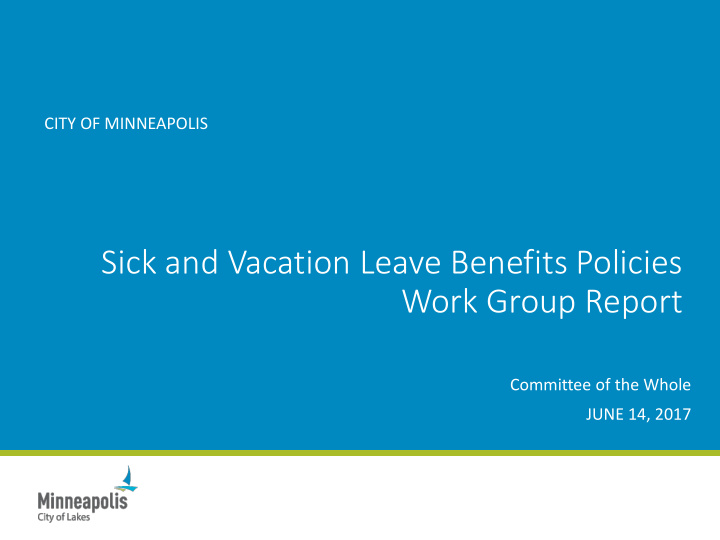



CITY OF MINNEAPOLIS Sick and Vacation Leave Benefits Policies Work Group Report Committee of the Whole JUNE 14, 2017
Charge to Work Group May 2016 Internal Audit report: P otential risks/costs related to extended use of sick and vacation leave prior to retirement System access termination at time of separation not timely May 2016 Council staff direction: Staff work group to “examine the benefits and risks in the City’s current sick and vacation leave policies in order to determine if modifications are warranted” Members: City Attorney, City Coordinator, Finance, HR, IT, Internal Audit, plus two labor representatives 1
Research and Analysis Examined historical and future projected costs of leave payouts Reviewed applicable city policies and labor contracts Surveyed other cities and counties Analyzed actual pre-retirement leave usage trends over last 5 years 2
Findings Annual and project future costs for leave payouts are stable: 3
Findings Labor contracts mostly consistent, with a few exceptions: Minimum sick leave accrual requirement Allocation of payouts to health care spending plan vs. direct lump sum payout to employee Pre-retirement notification by the employee Limitations on management authority to deny pre- retirement vacations [MERF] 4
Findings Minneapolis’ leave payout policies generally consistent with other jurisdictions surveyed: Like Minneapolis, most responding jurisdictions indicated they had no cap on sick leave accruals, but did have a cap on vacation accruals 43% of responders indicated that they pay ‘a portion’ of accrued sick leave upon retirement [Minneapolis pays 50%] Most jurisdictions reported that they do allow employees to use accrued sick/vacation time just prior to retirement, many on a “case by case basis” Less than half of the responding jurisdictions have a PTO program, many of which are limited to management or non-represented employees 5
Findings Overall the use of extended pre-retirement leaves is generally low: Table 1 Employee Sick and Vacation Usage Immediately Prior to Separation 2012 - 2016 Leave Usage During Final Week prior to Separation Leave Usage During Final Month prior to Separation # Of Used One Week Sick Used Two+ Weeks Sick Employees Used One Week Vacation Used Two+ Weeks of Vacation Leave [excluding FMLA] Leave [excluding FMLA] Separated Number* Percent Number * Percent Number * Percent Number * Percent 2012 212 3 1.4% 28 (3) 13.2% 9 4.2% 25 (4) 10.4% 2013 244 7 2.9% 40 (4) 16.4% 10 4.1% 43 (4) 18.0% 2014 282 8 (1) 3.2% 31 (4) 11.0% 18 (1) 6.4% 36 (4) 12.8% 2015 283 11 3.9% 32 (3) 11.3% 17 6.0% 26 (3) 9.2% 2016 288 13 4.5% 23 (1) 8.0% 15 5.2% 27 (3) 9.4% Total 1,309 42 (1) 154 (15) 69 (1) 157 (18) Average 261.8 8.4 3.2% 30.8 11.8% 13.8 5.3% 31.4 12.0% *Numbers in parentheses are MERF employees Source: COMET; Run Date 4/11/17 6
Findings But variations exist across departments: Table 2 Departments with largest percentage of Separating Employees using Significant Leave Time Prior to Separation 2012 - 2016 Used Two % Using Two # Of Weeks Sick % Using Two Used Two % Using Either Weeks Employees Time Weeks Sick Weeks of Two Weeks of Sick Vacation Seperated (Excluding Time Vacation OR Vacation Time FMLA) Fire 90 [61] 33 36.7% 11 (1) 12.2% 40.0% Public Works 287 11 (1) 3.8% 61 (14) 21.3% 26.8% Finance and Property Services 80 1 1.3% 12 (2) 15.0% 25.0% Police 269 16 5.9% 32 11.9% 20.8% Numbers in [] brackets are Fire Department employees with 54.6 hour workweeks. Numbers in () parentheses are MERF employees. Source: COMET Run date 4/11/17 7
Action Steps HR, Finance, and IT will roll out a more coordinated and timely protocol for termination of access to city systems upon retirement - October 2017 HR will develop more consistent citywide protocols and training for supervisors about appropriate pre-retirement sick and vacation leave usage; will take into account operational needs – 1 st quarter 2018 In early June HR issued an RFP to explore outsourcing of leave administration for 2018 HR will review variations in sick/vacation leave policies across the city’s 24 labor contracts and address as appropriate in future labor contract negotiations HR to return within 120 days with progress report 8
More recommend